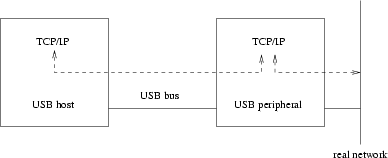Usage Scenarios
The USB-ethernet package can be used several different scenarios. In a simple scenario, the peripheral serves only to connect the USB host to a suitable network:
After initialization, and once the USB connection between host and
peripheral has been established, higher-level code needs to detect
packets that are intended for the host, and to forward these. This can
be achieved by the low-level usbs_eth_start_tx
function. Similarly, higher-level code needs to detect packets coming
from the host, using usbs_eth_start_rx, and to
forward these using the real network. As far as the host is concerned
it is connected directly to the network. In this scenario there is no
confusion about addresses: there is a single MAC address for the
host/peripheral combination, corresponding to the connection to the
real network, and it is this address which should be supplied during
initialization.
In a more complicated scenario, there is a TCP/IP stack running inside the peripheral.
This involves the USB-ethernet package providing a service both to the host and to the eCos TCP/IP stack. It achieves the latter by acting as an eCos network device. Typically, the TCP/IP stack will be configured to act as a network bridge. The USB peripheral needs to examine the packets arriving over the real network. Some of these packets will be intended for the host, while others will be intended for the peripheral itself. To distinguish between these two scenarios, two distinct MAC addresses are needed: one for the host, and one for the peripheral. Similarly, packets sent by the host may have to be forwarded via the real network, or they may be intended for the TCP/IP stack inside the peripheral. Packets generated inside the peripheral's TCP/IP stack may need to be sent via the real network or over the USB bus. The network bridge software will have to take care of all these possibilities. Unusually for a network bridge, one of the network segments being bridged will only ever have one machine attached.
There are other possible usage scenarios. For example, the peripheral might not be attached to a real network at all. Instead it could be the USB host that acts as a network bridge, allowing a TCP/IP stack inside the peripheral to communicate with the outside world. The various details will depend on the exact type of peripheral being developed.

